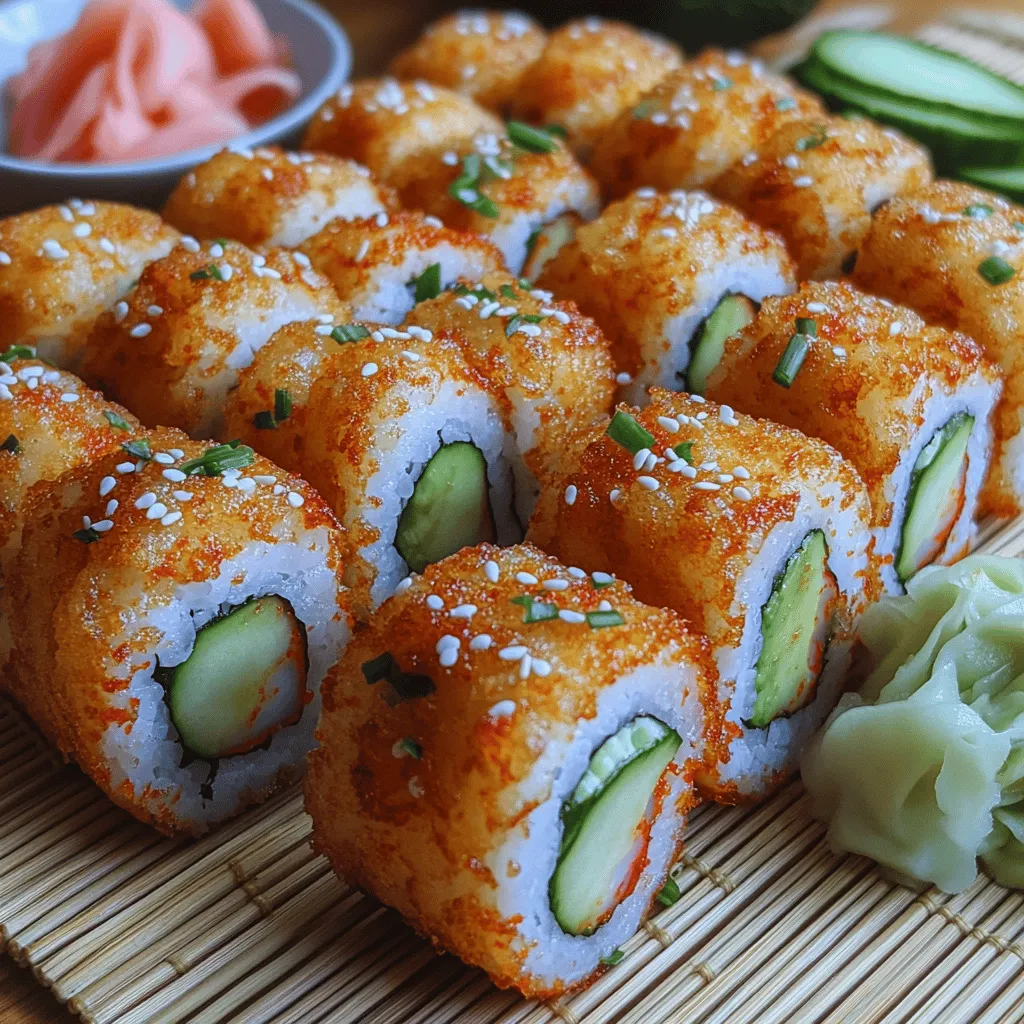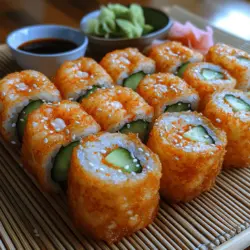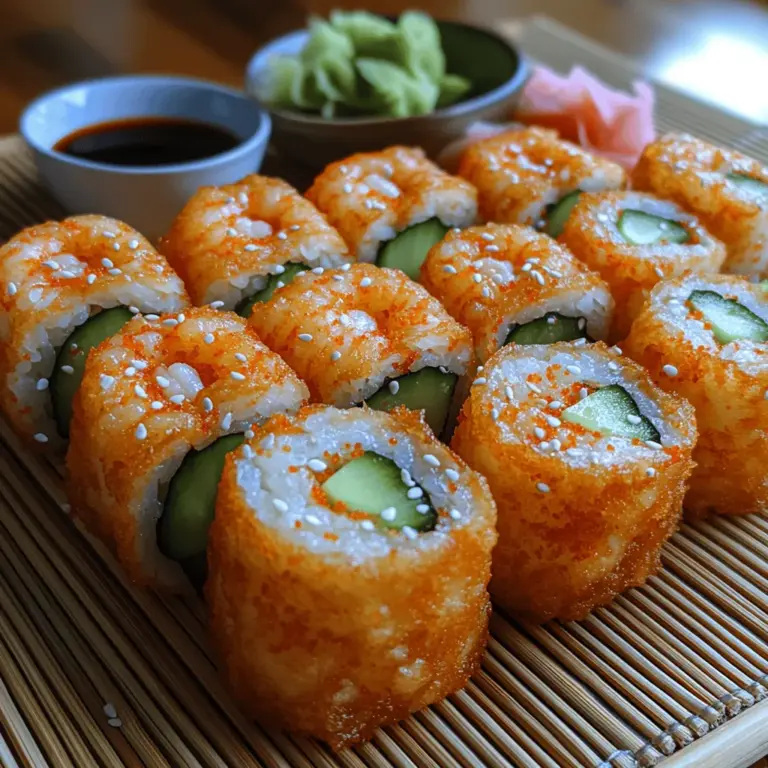Crispy Shrimp Tempura Rolls: A Delectable Introduction
Crispy shrimp tempura rolls are a delightful fusion of two beloved elements of Japanese cuisine: tempura and sushi. These rolls encapsulate the essence of fresh shrimp enveloped in a light, airy batter, which is then combined with sushi rice and fresh vegetables, all wrapped tightly in a sheet of nori. The result is a culinary masterpiece that appeals not only to the palate but also to the eye, offering a feast of flavors and textures in every bite.
The appeal of shrimp tempura rolls lies in their crunchy exterior that gives way to a tender filling. The juxtaposition of the crispy batter with the creamy avocado or crisp cucumber creates a delightful contrast that enhances the overall eating experience. These rolls are not only delicious but also visually striking, often garnished with a drizzle of eel sauce or a sprinkle of sesame seeds that elevate their presentation. For many, shrimp tempura rolls are a favorite choice at sushi restaurants, and they can easily become a beloved dish in home kitchens as well.
The cultural significance of sushi and tempura in Japanese cuisine cannot be overstated. Sushi has evolved from its origins as a method of preserving fish to a widely enjoyed delicacy around the world. Similarly, tempura, which has its roots in the 16th century Japanese cuisine, was influenced by Portuguese cooking techniques. The combination of these two culinary traditions in the form of shrimp tempura rolls offers a delicious glimpse into the rich tapestry of Japanese food culture. As you embark on this culinary journey, this article will guide you step-by-step through the process of making your very own crispy shrimp tempura rolls at home.
Understanding Shrimp Tempura Rolls
At its core, shrimp tempura rolls are a type of maki sushi, which refers to sushi rolls that are rolled with rice and various fillings, wrapped in seaweed. The origins of tempura are particularly interesting. It is believed to have been introduced to Japan by Portuguese missionaries and traders in the 16th century. Originally, the dish consisted of seafood and vegetables that were battered and deep-fried, a cooking method that quickly gained popularity among the Japanese.
Sushi rolls, on the other hand, have a diverse array of variations, ranging from traditional nigiri to more modern interpretations like the California roll. The common thread among all sushi is the careful balance of flavors and textures—sweet, salty, crunchy, and smooth—all harmonizing to create an extraordinary experience. In shrimp tempura rolls, the sweet, succulent shrimp contrasts beautifully with the rich, creamy textures of avocado and the slight crunch of fresh vegetables, all harmonized by the umami-rich nori and seasoned sushi rice.
Understanding these components is key to mastering the art of crafting shrimp tempura rolls. Each ingredient plays a vital role not only in the final flavor profile but also in the overall presentation of the dish.
Ingredients Breakdown
To create the perfect crispy shrimp tempura rolls, you will need a selection of high-quality ingredients. Here’s an overview of the main components that come together to make this dish truly exceptional:
1. Shrimp: The star of the show, shrimp should be fresh and of high quality. Look for large or extra-large shrimp, which provide a satisfying bite. They should be peeled and deveined before cooking.
2. Tempura Batter: The batter is crucial for achieving that signature crunch. A simple blend of cold sparkling water, all-purpose flour, and cornstarch creates a light, airy texture. Using sparkling water helps to keep the batter cold and yields a crispier result.
3. Nori: This dried seaweed sheet is essential for holding the roll together. It adds a subtle umami flavor and a unique texture that complements the other ingredients.
4. Sushi Rice: Short-grain rice is typically used for sushi because of its sticky nature, which helps keep the roll intact. The rice is seasoned with rice vinegar, sugar, and salt, enhancing its flavor.
5. Vegetables: Common choices include cucumber and avocado, both of which add freshness and creaminess to the roll. You can also experiment with other vegetables like bell peppers or carrots for added color and crunch.
Each of these ingredients works together to create the harmonious blend of flavors and textures that define crispy shrimp tempura rolls. For those with dietary preferences, consider substituting shrimp with tofu or tempura-fried vegetables for a vegetarian version.
Preparation Steps for Crispy Shrimp Tempura Rolls
Preparing the Shrimp
Before diving into the frying process, it’s essential to prepare the shrimp properly. Start by selecting fresh shrimp from a reputable source. Look for shrimp that have a firm texture and a mild, briny smell, indicating their freshness. To prepare the shrimp, rinse them under cold water and pat them dry with paper towels. This step is crucial, as excess moisture can lead to a soggy batter during frying.
Once dried, season the shrimp lightly with salt and a pinch of pepper to enhance their natural flavor. This simple seasoning step is often overlooked but can significantly elevate the overall taste of the final dish.
Making the Tempura Batter
The tempura batter is the heart of crispy shrimp tempura rolls, and achieving the right consistency is key. In a mixing bowl, combine equal parts of all-purpose flour and cornstarch. The cornstarch contributes to the crispiness and helps to create a light texture.
Next, gradually add cold sparkling water to the dry ingredients, stirring gently with chopsticks or a fork until just combined. The batter should be lumpy and not overly mixed; over-mixing can lead to a denser texture rather than the desired light and crispy coating. The cold temperature of the sparkling water is essential, as it helps to create steam during frying, resulting in a crunchy exterior.
Heating the Oil
To achieve the perfect crispy shrimp, it’s crucial to heat the oil to the right temperature. A deep fryer or a heavy-bottomed pot works best for frying. Fill it with vegetable oil or canola oil to a depth of at least two inches and heat it over medium-high heat.
The ideal frying temperature for tempura is around 350°F (175°C). If you don’t have a thermometer, you can test the oil’s readiness by dipping the end of a wooden chopstick into the oil. If bubbles form around the chopstick, the oil is ready for frying.
Once the oil is heated, it’s time to dip the prepared shrimp into the tempura batter, allowing any excess to drip off before gently placing them into the hot oil. Fry in small batches to avoid overcrowding, which can lower the oil temperature and result in greasy shrimp. Cook until golden brown, usually about 2-3 minutes, then remove them with a slotted spoon and place them on a paper towel-lined plate to drain excess oil.
With these initial steps completed, you are well on your way to creating delicious crispy shrimp tempura rolls. The process may seem intricate, but the rewards of homemade sushi are well worth the effort. Stay tuned for the next part of this article, where we will delve into rolling techniques, additional ingredients, and the final touches that will elevate your shrimp tempura rolls to restaurant-quality perfection.

Safety Tips for Frying at Home
Frying at home can be a delightful experience, but it is essential to prioritize safety to prevent accidents. Here are some crucial safety tips to keep in mind while preparing your crispy shrimp tempura rolls:
1. Use Deep Frying Equipment: Invest in a heavy-bottomed pot or deep fryer to ensure even heating and stability. A thermometer is also a worthwhile addition to monitor oil temperature accurately.
2. Maintain Oil Temperature: Keep the oil temperature between 350°F to 375°F (175°C to 190°C). An oil thermometer can help you maintain the ideal temperature, reducing the risk of burns or fires.
3. Avoid Overcrowding: Fry shrimp in small batches to prevent the oil temperature from dropping too low, which can lead to soggy tempura.
4. Use a Splatter Guard: To minimize mess and potential burns, consider using a splatter guard over the frying pot. This will help contain any oil that splatters during the frying process.
5. Have a First Aid Kit Handy: Accidents can happen, so it’s wise to have a first aid kit nearby. Know how to treat minor burns with cool water and sterile dressings.
Frying the Shrimp
Step-by-Step Instructions for Frying the Shrimp
1. Prepare the Shrimp: Start with peeled and deveined shrimp. Pat them dry with a paper towel to remove excess moisture, as this will help achieve a crispy texture.
2. Make the Tempura Batter: In a bowl, mix 1 cup of all-purpose flour, 1/2 cup of cornstarch, and 1 teaspoon of baking powder. Gradually add ice-cold water until you achieve a smooth batter consistency. It should be slightly thick but still pourable.
3. Heat the Oil: Pour vegetable oil into your frying pot, filling it about 2-3 inches deep. Heat the oil over medium-high heat until it reaches the desired temperature of 350°F to 375°F.
4. Coat the Shrimp: Dip each shrimp into the tempura batter, ensuring it’s fully coated. Allow excess batter to drip off before placing it into the hot oil.
5. Fry the Shrimp: Carefully lower the shrimp into the hot oil one at a time, ensuring not to overcrowd the pot. Fry for about 2-3 minutes on each side, or until the shrimp turn a light golden brown and are fully cooked.
Visual Cues to Look for During Frying
As the shrimp fry, keep an eye out for these visual cues:
– Color: The shrimp should turn a beautiful golden brown. If they start to darken too quickly, reduce the heat.
– Texture: The batter should appear light and crispy. Avoid frying until the batter is dark as this may indicate overcooking.
How to Properly Drain Excess Oil
Once the shrimp are done frying, use a slotted spoon to remove them from the oil. Place them on a plate lined with paper towels to absorb excess oil. This step is crucial for maintaining the crispiness of the tempura.
Assembling the Rolls
Detailed Instructions on Laying Out the Nori and Sushi Rice
1. Prepare the Sushi Rice: Cook the sushi rice according to package instructions and then season it with a mixture of rice vinegar, sugar, and salt. Let it cool to room temperature.
2. Lay Out the Nori: Place a sheet of nori, shiny side down, on a bamboo sushi mat or a clean cutting board. Ensure that the nori is positioned horizontally.
3. Spread the Sushi Rice: Wet your hands with water to prevent sticking, then take a handful of sushi rice and evenly spread it over the nori, leaving about 1 inch of space at the top edge.
Techniques for Rolling the Sushi Tightly and Evenly
1. Add Fillings: Place the fried shrimp in the center of the rice, along with any desired fillings like sliced avocado or cucumber.
2. Start Rolling: Begin to roll the sushi mat away from you, tucking the edge of the nori over the filling. Apply gentle pressure to ensure a tight roll.
3. Wetting the Nori for Sealing: Before finishing the roll, wet the exposed edge of the nori with a little water to help seal it. Finish rolling until the sushi is complete.
Importance of Leaving a Border
Leaving a border at the top of the nori is vital for sealing the roll properly. A well-sealed roll will hold its shape when sliced, ensuring clean edges and a perfect presentation.
Slicing and Presentation
Best Practices for Slicing the Rolls
To achieve clean slices for your tempura rolls, follow these best practices:
1. Use a Sharp Knife: A sharp knife is crucial for slicing sushi. A dull knife can crush the roll and ruin its shape.
2. Wipe the Knife: Between slices, wipe the blade with a damp cloth to prevent sticking and to achieve cleaner cuts. This also helps maintain the integrity of the roll.
3. Slice at an Angle: For an aesthetically pleasing presentation, slice the rolls at a slight angle. This technique shows off the beautiful layers of filling.
Visual Presentation Tips
To enhance the visual appeal of your shrimp tempura rolls:
– Arrange Neatly: Place the sliced rolls on a platter or individual plates, ensuring they are spaced evenly.
– Garnish: Sprinkle sesame seeds on top for added texture and flavor. Thinly sliced green onions or a drizzle of eel sauce can add a beautiful touch.
Serving Suggestions
Traditional Accompaniments
Serve your crispy shrimp tempura rolls with classic accompaniments to elevate the dining experience:
– Soy Sauce: A must-have for dipping, soy sauce enhances the umami flavor of the rolls.
– Wasabi: Add a touch of wasabi for some heat. A little goes a long way!
– Pickled Ginger: This refreshing side helps cleanse the palate between bites.
Creative Serving Ideas for a Sushi Platter
Consider creating a sushi platter with an assortment of rolls, including vegetarian options. Adding colorful garnishes like edible flowers or vibrant vegetables can make your presentation pop.
Pairing Suggestions with Beverages
Pair your shrimp tempura rolls with beverages that complement the flavors:
– Sake: A chilled or warm sake pairs beautifully with sushi, enhancing the overall experience.
– Green Tea: A cup of green tea serves as a refreshing palate cleanser that complements the meal.
Nutritional Information
Breakdown of Nutritional Content per Serving
These crispy shrimp tempura rolls are a delightful treat! Here’s a rough nutritional breakdown per serving (2 rolls):
– Calories: Approximately 350-400
– Protein: 18g
– Fat: 20g (mostly from the shrimp and frying oil)
– Carbohydrates: 30g
– Fiber: 2g
Health Benefits of the Ingredients Used
– Shrimp: A great source of lean protein, shrimp is low in calories and high in essential nutrients like selenium and vitamin B12.
– Avocado: Rich in healthy fats, fiber, and potassium, avocado adds creaminess and nutrition to your rolls.
– Nori: This seaweed is packed with vitamins and minerals, including iodine and omega-3 fatty acids, contributing to a balanced meal.
Conclusion
Making crispy shrimp tempura rolls at home is not only rewarding but also a fantastic way to enjoy a Japanese culinary classic. The process of frying, assembling, and presenting these rolls allows for creativity and exploration in the kitchen. Whether you’re preparing them for a special occasion or a casual meal, these rolls are sure to impress.
Encourage your creativity by experimenting with variations and presentations. Try different fillings, such as tempura vegetables or spicy tuna, and explore unique dipping sauces to enhance your dining experience. By engaging in this delightful culinary adventure, you not only develop your cooking skills but also gain a deeper appreciation for the flavors and traditions of Japanese cuisine. Enjoy your homemade crispy shrimp tempura rolls and the joy they bring to your table!

